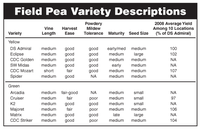Producers May Want to Consider Field Peas
(Click the image below to view a high-resolution image that can be downloaded)
Field peas (Pisum sativum L.), native to southwest Asia, were among the first crops brought under cultivation by man. The largest acreages of field peas in the U.S. are in North Dakota, Idaho, Oregon and Washington.
“As a cool-season legume crop, it fits well into small-grain rotations,” says Hans Kandel, North Dakota State University Extension agronomist for broadleaf crops.
The green and yellow-seeded varieties are used for human consumption as dry split field peas. Field peas also are used as protein concentrates for livestock and pigeon feeds. In North Dakota, pea yields equal hard red spring wheat yields.
Field peas also can be used as a forage crop for hay, pasture or silage. Field peas grown in a mixture with oats, barley or triticale yield more dry matter per acre than a straight pea crop.
“Field pea stems grow to a length of 2 to 4 feet,” Kandel says. “A true leaf consists of one to three pairs of leaflets, with a terminal, branched tendril. The flowers are reddish purple or white. The pods are about 3 inches long and contain four to nine seeds.”
A cool growing season is necessary for optimum pea yields (a mean temperature of 55 degrees to 65 degrees). Hot weather during flowering may result in a reduced seed set. In North Dakota, field peas take about 60 days from seeding until flowering and 95 to 100 days to maturity.
Kandel suggests that producers select a variety that is suitable for his or her farm operation and marketing strategy.
The moisture requirement for field peas is similar to that for cereal grains.
“Field peas can be grown on a wide range of soil types, but there must be good drainage because field peas do not tolerate saturated or soggy conditions,” Kandel says. “Field peas can be grown in a no-tillage or conventional-tillage cropping system. It grows best when seeded into a weed-free seedbed and fertile soils. Land preparation for seeding is similar to that of wheat. In order to obtain good soil-to-seed contact, seedbeds should be firm, and avoid seedbeds with large clods. Do not work the soil too finely or subsequent soil crusting following rains may cause poor emergence.”
Drill the seeds 1 to 3 inches deep in rows 6 inches apart as early in the spring as feasible. The soil should not be excessively wet at seeding. Seeding can be done with an air seeder or grain drill.
“Adjust the seeder to prevent cracking of the seed, especially with the large-seeded varieties because cracked seed will not germinate,” Kandel says. “Do not pack or roll immediately after seeding if the soil moisture is high or excess compaction or crusting can occur.”
Pea seedlings can withstand considerable frost. Even if the frost is severe enough to kill the main shoot, the pea plant will regrow from buds at one of the nodes at or below the soil surface. However, this will delay plant maturity.
Field peas are capable of utilizing bacterially fixed atmospheric nitrogen.
“The specific bacterial association for nitrogen fixation in field peas and lentils is with the bacterium Rhizobium leguminosarium, which is a different bacteria species than is used for soybean inoculation,” Kandel says. “If field peas are to be grown in a field for the first time or no peas were grown there recently, inoculating the seed with the proper Rhizobium prior to planting may increase nodulation. The pea seed germination rate increases with increasing temperatures. However, at temperatures greater than 64 degrees, the percentage of seed germination decreases.”
Treating the seed with a fungicide can improve emergence significantly. Fungicide labels should be checked to see if a particular fungicide can be used on field peas.
Having level ground is critical for easy harvesting. Stony fields should be avoided or rolled after seeding to bury loose stones that might be picked up during swathing and harvesting.
For more information on pea production, go to http://www.ag.ndsu.edu/pubs/plantsci/rowcrops/a1166w.htm. For variety selection information, go to http://www.ag.ndsu.edu/pubs/plantsci/crops/a1105.pdf.
NDSU Agriculture Communication
| Source: | Hans Kandel, (701) 231-8135, hans.kandel@ndsu.edu |
|---|---|
| Editor: | Rich Mattern, (701) 231-6136, richard.mattern@ndsu.edu |


